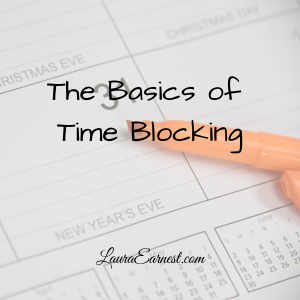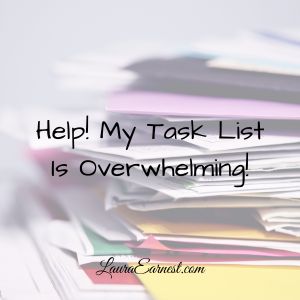Time blocking is a great way to get things done. But it doesn’t mean putting all of your tasks on your calendar.
Want to make me cringe? Tell me you put all of your tasks on your calendar so that you have time set aside to do them.
No. No. Just no.
The Problem With Tasks On Calendars
Very few (read: no) people are good at estimating how long a task will take, unless it is something they do day in, day out, for years, never varying the method. For tasks that don’t get done as often, humans are absolutely terrible at time estimation.
(And I say that as someone whose job involves a lot of estimation – and I am within 10% of my estimate only about 50% of the time)
When people put all of their tasks on a calendar, they’re going to do it according to how long optimistically they think it will take. (And if they don’t think about it, it will fall into 30 minute increments, as the default from the calendar). But tasks never run that smoothly.
The problem is that if even one thing runs long, the whole schedule shifts. Have a few things run long and all of a sudden your tasks are falling off the edge of your schedule like Disney’s lemmings. (See the Britannica article for that myth busting)
So, given the fact that a person will estimate wrong most of the time, that means that the chances of having a day where all tasks go as planned is almost zero. And that means day after day of watching your schedule fall apart and not getting your tasks done.
Talk about demoralizing. I think I’d give up trying to be productive.
Using Blocks
There is an alternative, and that is using time blocks.
A block is a chunk of time that is dedicated to working on a certain task or group of tasks. These can be put into any schedule, varying each day.
There’s a couple of things you need to note about that definition: working on and varying.
Finishing Is Nice, But Not Necessary
The first key to making time blocking work is to accept that you might not finish your planned-for work during the block.
Let’s face it: life happens. You may be well on your way to finishing your tasks for a block when the milk gets spilled on the dog and then the dog gets stuck to the vacuum. And when life happens that means you are not going to execute your plan.
Time blocking is about setting aside dedicated time to work on something. It doesn’t mean you will finish, or that you should push the end of the time block so you can finish. Pushing the end just throws the rest of your schedule out of whack.
Finishing is a bonus, not a goal, of time blocking.
Blocks Vary
Just because you have an hour on one day and you were able to power through a list of tasks doesn’t mean it will always happen that way. (See Life Happens, above). But what you should tackle and when will depend a lot on the energy you have at the moment.
Some days are just meant to sprint through tasks. There are days when everything is effortless, we’ve all had a few of those. Unfortunately, it is more likely that you will have a day when it’s like wading through molasses.
Blocks allow you to spend time on a task or group of tasks, but just like finishing, you can’t be set on having the same group of tasks accomplished in the same amount of time every time.
How To Block
Blocking is fairly straightforward. You identify your blocks of time, and then match them up with a group of tasks or a task area you want to work on.
Identifying Blocks
Identifying blocks of tasks consists of looking at what is already scheduled, and then finding the time between. The easiest way to do this is to lay your day out on a grid, and then find the empty spots. You can do it on a spreadsheet, a sticky note, a single line on a graph paper (see how I do this daily in My Bullet Journal Setup) or on an empty sheet of paper. List all the hours, and then block out your commitments.
As an example, we’ll use my schedule for this afternoon:
| Time | Block |
| 1:00-2:30 | Coding on application product |
| 2:30-3:00 | Design meeting: order of magnitude on interest rate storage |
| 3:00-4:30 | Coding on application product |
| 4:30-5:00 | |
| 5:00-5:30 | Voice Lesson |
| 5:30-6:30 | |
| 6:30-7:30 | Dinner prep/eat |
| 7:30-8:30 | Choir |
| 8:30-10:00 |
As you can see, there are several blocks that are not filled out. We will fill those with tasks.
Grouping Tasks
For each block of time, I can either group tasks together, or assign a general task.
My tasks this afternoon consist of the following:
- Clean the cat boxes
- Set up FAFSA appointment
- Buy gifts for parents
- Write up Joy to the World slides for 12/24
- Update Mari Lywd lyrics on sheet music
- Finish 12/14 blog article
- Work on book/character brainstorming
- Put away laundry
- Make Facebook Graphic for Yule
I generally group by location and/or equipment.
- Clean the cat boxes (near writing studio)
- Set up FAFSA appointment (computer)
- Buy gifts for parents (computer)
- Write up Joy to the World slides for 12/24 (computer)
- Update Mari Lywd lyrics on sheet music (music room)
- Finish 12/14 blog article (writing studio)
- Work on book/character brainstorming
- Put away laundry (bedroom)
- Make Facebook Graphic for Yule (computer)
I can then group the tasks together.
Assigning Task Groups to Blocks
Once I have the groups, I slot them into the schedule.
| Time | Block |
| 1:00-2:30 | Coding on application product Schedule FAFSA during test run |
| 2:30-3:00 | Design meeting: order of magnitude on interest rate storage |
| 3:00-4:30 | Coding on application product Clean cat box during test run |
| 4:30-5:00 | Buy gifts for parents Make slides Make Facebook graphic Update Mari Lwyd |
| 5:00-5:30 | Voice Lesson |
| 5:30-6:30 | Put away laundry Blog |
| 6:30-7:30 | Dinner prep/eat |
| 7:30-8:30 | Choir |
| 8:30-10:00 | Work on book |
I scheduled two of my smaller tasks during my workday, since I know that each block of coding will have a 10 minute testing run. I can’t do anything while the code is testing, so I might as well knock out tasks.
Right after work, but before my voice lesson, I decided to work on my computer. I put all the computer tasks together there. I will tackle the update to the lyrics as I am getting ready for my voice lesson, since it uses the same physical area as the voice lesson.
After my voice lesson, I have to pass through my bedroom to get to my writing studio. So I will put the laundry away as I walk through to blog.
My blogging block doesn’t have tasks assigned. Although I need to finish this article, if I finish early there are other tasks I can move on to, so the block is labeled “blog”. The same applies to the writing block.
Blocking Doesn’t Have To Be Difficult
Looking at my schedule, I see that there are a couple of blocks that might not get everything done. For instance, the site I was ordering presents from had some sort of glitch and told me to come back later. So I’ll do that right before I start writing.
I spend most of my days using this sort of formatted time blocking. It helps me stay on track and get things done.
If you are struggling with time blocking, leave a comment below and I will address your issues in another article.







